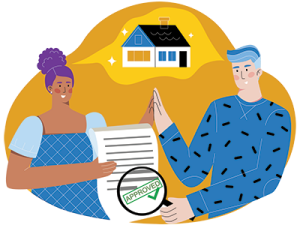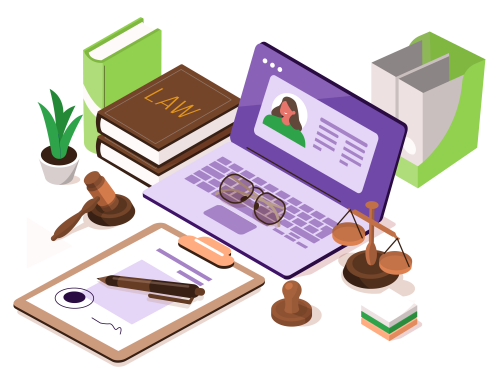Joint Borrower Sole Proprietor Mortgage
A Joint Borrower Sole Proprietor (JBSP) (also called a Joint Mortgage Sole Proprietor or Borrower Non-Proprietor) mortgage allows a loved one, often a parent, to join a mortgage application as a borrower, boosting the applicant's affordability without them becoming a legal owner of the property. It's a smart way for first-time buyers to step onto the property ladder sooner.
While the idea is simple – more buying power – understanding how a JBSP mortgage works is vital. Because the supporting borrower takes on the responsibility for the mortgage loan without the direct benefit of owning the home, there are specific things you need to know to ensure everyone involved is protected. Think of it as having a co-signer who helps you get the loan but doesn't get the keys.
Independent Legal Advice (ILA) is required so that borrower who isn't the legal owner fully understands the financial implications and the risks. Some might think that ILA isn't necessary because you're usually increasing a family member's affordability.
In reality, the risk of being liable for the whole mortgage, including future borrowing against the property, means that you could be unable to afford a property of your own or face rejection for a remortgage.
What is a Joint Borrower Sole Proprietor Mortgage?
The Joint Borrower Sole Proprietor mortgage product has the same principles as a guarantor mortgage, however, there are differences.
The main one is that instead of someone guaranteeing the mortgage if the borrower doesn't pay because the guarantors are named as the borrowers, all borrowers are jointly and several liable to pay the mortgage repayments each month.
This product is aimed at applicants who cannot afford a full mortgage on their own but can do so with the help of a joint applicant. Mortgages are offered to borrowers based on their income, so the smaller your income, the less you're able to borrow.
The second borrower takes on liability for the mortgage, but won't be a registered legal owner of the property.
How to apply for a JMSP
Generally, the application process involves the following key stages:
- Initial Consultation - you'll discuss your financial situation and homeownership goals with your experienced mortgage broker. They will help you understand your affordability, eligibility, and compare various lenders and products for your situation.
- Documentation and Agreement in Principle (AIP) - documents for your (and the other joint borrower's) proof of income, ID, bank statements, and details of existing debts are required here for the lender to look over. The lender will then issue an AIP, also known as a Decision in Principle, to indicate how much they might be willing to lend you.
- Property Search and Full Application - once you have your budget, you'll start the property search, and once you've had an offer accepted on one, you'll proceed with the full mortgage application.
- Solicitor Instruction and ILA - here you'll formally instruct a solicitor to work on your behalf in the purchase, and the non-proprietor will need to receive Independent Legal Advice from a solicitor before the mortgage is finalised.
- Completion - the mortgage will be finalised, the solicitor draws down funds to pay for the property, and you'll move into your new home.
The difference between a Joint Mortgage and a Joint Mortgage with Sole Ownership
- Some of the borrowers aren't registered on the legal title.
- All parties, whether legal owners or not, are equally liable to repay the full mortgage debt.
- All parties, whether legal owners or not, are bound by the terms of the mortgage.
- You can avoid second home stamp duty if you draft a deed.
- The non-legal owners don't have the right to sell, use, or transfer their names from the legal title.
Are interest rates different for a JBSP Mortgage?
The interest rates for Joint Borrower Sole Proprietor mortgages are not inherently different from those of standard residential mortgages; you'll find products on the market between 3.8% to 5.7%. The interest rate you'll be offered will depend on a variety of factors, primarily:
- The lender: Different lenders have different pricing models and risk appetites. Some lenders may specialise in certain types of mortgages, including JBSP, and their rates might be more competitive for these products.
- The financial profile of the borrowers: This includes the credit scores, income, and existing debts of both the main applicant and the joint borrower. A stronger financial profile across both parties may lead to more favourable interest rates.
- The loan-to-value (LTV) ratio: This is the amount you're borrowing as a percentage of the property's value. Typically, a lower LTV (meaning you have a larger deposit) can result in a lower interest rate.
- The type of interest rate: You'll usually have a choice between a fixed-rate mortgage (where the interest rate remains the same for a set period) or a variable-rate mortgage (where the interest rate can fluctuate with market conditions). The type you choose will impact the rate you pay.
- The specific mortgage product: Even within the JBSP category, lenders may offer different products with varying features and interest rates.
What are the JBSP mortgage product fees?
Product Fee
This is a fee that some lenders charge for the specific mortgage product you choose. It can sometimes be added to the total loan amount or paid upfront.
Product fees vary significantly between lenders and different mortgage deals. It's important to consider whether paying a product fee upfront results in a lower interest rate overall, and to calculate the total cost of the mortgage over the term to make the most cost-effective choice.
Intermediary fee
This is the fee charged by your mortgage broker for their services in helping you find and arrange your JBSP mortgage. At SAM, we believe in transparency and offer a free initial 15-minute appointment with one of our panel mortgage brokers.
Mortgage Discharge Fee
Also known as an exit fee or redemption fee, this is a charge that some lenders apply when you pay off your mortgage, either at the end of the term or if you remortgage to a new lender.
The amount of this fee can vary, so it's worth checking the terms and conditions of your mortgage offer to understand if a discharge fee applies and how much it is.
Our brokers will present the best options available to you, for any type of mortgage, including:
- First-time buyers, home movers and buy-to-lets;
- Employed; self-employed or director mortages;
- Mortgages for non-UK residents or non-UK citizens;
- Bridging loans;
- Bad credit mortgages;
- Guarantor mortgages;
- Joint borrower, sole proprietor mortgages; and
- Absolute, Possessory, Good, or Qualified Title.
Can you make annual overpayments?
Yes, many mortgage lenders, including those offering Joint Borrower Sole Proprietor mortgages, typically allow you to make annual overpayments on your mortgage.
Making overpayments can be a smart way to reduce the overall interest you pay over the life of the loan and potentially shorten your mortgage term. Even small, regular overpayments can make a difference in the long run.
The specific terms and conditions regarding overpayments can vary between lenders. For example, some lenders may allow you to make annual overpayments of up to 10% of your outstanding mortgage balance without incurring any early repayment charges. This flexibility can be very beneficial if you come into extra funds, such as a bonus or inheritance.
It's important to check the overpayment policy of any JBSP mortgage you are considering. Some lenders may have restrictions on the amount you can overpay or charge a fee for overpayments exceeding a certain limit, especially during the initial fixed-rate period of the mortgage.
Why would someone use a JBSP Mortgage?
A JBSP mortgage is used often for these two reasons:
- 1
Avoiding Second Home Stamp Duty
The most common reason for using a JBSP mortgage.
Parents who own a house can help their children buy a home without incurring the additional rate of SDLT. Similar for unmarried couples buying together.
Married couples rarely use this mortgage because it doesn't matter if either one is on or off the legal title, if a husband or wife owns an interest in another property then they have to pay second home stamp duty.
- 2
Allowing the buyer to be the sole legal owner
Similar to the reason for guaranteeing the property, the objective of a parent is to help their adult child buy a home.
With this mortgage, they can do that without needing to have their name on the legal title which gives a feeling of ownership for their children.
While the objective is to help with mortgage affordability, in the hope you can remove your name as a borrower in the future, parents can be left waiting years to get removed from the product.
This affects future borrowing for themselves, and the tax risks if not structured correctly could mean you pay the Additional Rate of Stamp Duty.
- 3
Coming onto a mortgage while retaining First-Time Buyer relief
Someone might come onto the mortgage using a JBSP product while also aiming to retain their first-time buyer relief when they eventually buy their own property.
Again, usually it's mum and dad agreeing to have their names attached to the mortgage, but friends and other relatives could also add themselves because they won't be entitled to any gain in the property. It's this which is key in retaining their FTB relief.
- Bespoke appointments from 9am-5pm Mon-Fri. Contact us for out-of-hours appointments.
- Availability from 29/11/2025.(i)
- Video conference to your home/work.
- Etridge Letter/Advisory Letter provided confirming ILA.
- On all lender panels, including TMW, Pepper, BM Solutions, HSBC, Metro, and Barclays.
Who is liable to repay the mortgage?
With a Joint Borrower Sole Proprietor mortgage, the liability for repaying the mortgage rests with all individuals named as borrowers in the mortgage agreement. This is a principle known as joint and several liability.
The non-occupying borrower must note that despite not being named on the title to the property over which this mortgage is secured, they are jointly and severally liable for this mortgage, together with the occupying borrower.
This means that you are each individually responsible for complying with the conditions of this mortgage in full and that the lender can enforce the mortgage against any of you for any sum owing.
Therefore, even if you are not living in the property, as a joint borrower, you are equally responsible for ensuring that the mortgage repayments are made on time and in full.
If the occupying borrower defaults on the payments, the lender has the right to pursue you for the outstanding debt. Similarly, if you are the occupying borrower, the lender can also pursue the non-occupying borrower if you fail to make payments.
Pros and cons of a JBSP mortgage
Pros
- There is no stamp duty liability for the additional borrowers.
- The sole proprietor can take over the mortgage if and when they have a larger income.
- Allows more people to get on the property ladder, and sooner.
Cons
- All borrowers have joint responsibility for the mortgage repayments. If the legal owner defaults on payments, the non-legal owner is left with the debt. It is crucial for non-legal owners to fully understand these risks by seeking Independent Legal Advice.
- You cannot use this mortgage as well as a housing scheme like Shared Ownership. However, it's best to check with your preferred mortgage provider to see if they can offer a bespoke product for your circumstances.
- If the additional borrower is elderly, this could limit the mortgage terms.
Joint Mortgage Sole Proprietor Process
- 1
Get an offer from a JBSP mortgage lender
Several mortgage lenders offer a Joint Mortgage Sole Proprietor product. Each of the mortgage lenders has a different approach to the application and what information they provide for the Independent Legal Advice.
We work regularly with these mortgage lenders and can guide you through what you need to do.
- 2
Draft a declaration of no beneficial interest
- Protects the legal owner and mortgage lender - Within the Deed of Trust the legal owner and non-legal owner can set out their intentions for the arrangement such as what to do when either party wants to leave, what happens if you are unable to make mortgage repayments, or who is liable should there be a breach to the terms of the Deed of Trust.
- Evidence of zero beneficial interest - A Deed of Trust can be drafted to evidence a joint borrower has no future entitlement to capital proceeds from the sale of the property to any income, or to occupy the property. Without written evidence, and if in the future any of these benefits are evidenced by HMRC, the transaction could have a higher rate of stamp duty applied to it if the non-legal owner has an interest in another property.
A Declaration of No Interest is required for the protection of the parties on the mortgage but not on the legal title. It's used to demonstrate the non-legal owner has zero beneficial interest in the property.
It's important to note that the non-legal owner will have no claim against the lender if they are forced to repossess.
- 3
Get Independent Legal Advice
- Review all of the mortgage documentation and financial statements.
- Draft and send an Etridge Letter to you summarising the discussion and asking you to sign and send back an acknowledgement.
- Complete the mortgage certificate and supply it to the bank.
As part of the mortgage offer conditions, the non-legal owner is required to receive ILA from a solicitor. This is to ensure they fully understand their obligations and the risks involved in taking on mortgage liability without being the legal owner of the property.
The legal advisers act on behalf of the mortgage lender and are instructed to ensure they have provided independent advice to the non-legal owners in relation to the JBSP mortgage product.
Your solicitor will:
- 4
Conveyancing Process
- A parent can be jointly on the mortgage, but their child is the sole legal owner, and vice versa.
- A friend can be jointly on the mortgage, but their friend is the sole legal owner.
- A partner can be jointly on the mortgage, but their partner is the sole legal owner.
The conveyancing process is the same as a normal purchase. Here are a few scenarios where this type of mortgage product is used:
Each circumstance is different, and mortgage lenders will review each individual case separately. In every case, separate legal advice is required.
For example, if both parents go on a mortgage but their adult child is the sole legal owner, they may only need one ILA meeting.
Which banks offer Joint Borrower Sole Proprietor Mortgages?
Our independent mortgage brokers have access to the whole market and will advise on the best product for your situation. Here is the list of mortgage lenders offering a JBSP mortgage product:
Andrew started his career in 2000 working within conveyancing solicitor firms and grew hands-on knowledge of a wide variety of conveyancing challenges and solutions. After helping in excess of 50,000 clients in his career, he uses all this experience within his article writing for SAM, mainstream media and his self published book How to Buy a House Without Killing Anyone.
Caragh is an excellent writer and copy editor of books, news articles and editorials. She has written extensively for SAM for a variety of conveyancing, survey, property law and mortgage-related articles.











